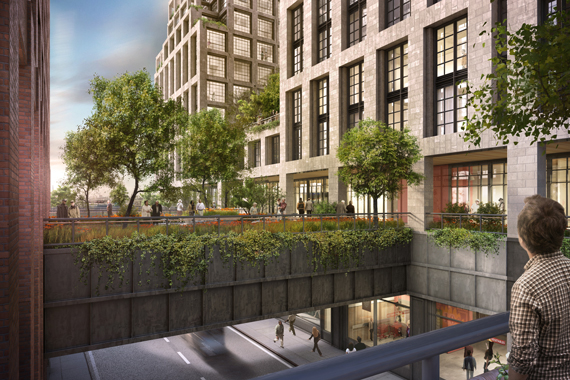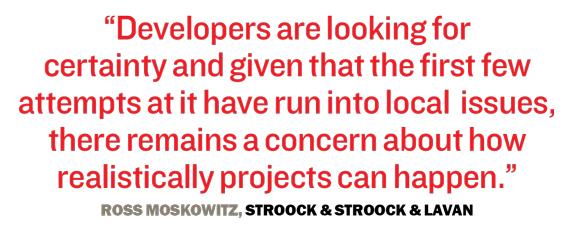Trending
False start
Can the mayor’s affordable housing plan succeed if communities won’t accept its key initiative?

When the City Council passed sweeping changes to the city’s zoning code in March, it was heralded as a major victory for Mayor Bill de Blasio’s affordable housing plan. “The scope and magnitude of these proposals cannot be understated,” Melissa Mark-Viverito, the City Council speaker, told Politico at the time. “They will fundamentally change how our city approaches affordable and senior housing production.”
But just a few months later, Mandatory Inclusionary Housing, which is both the most dramatic of those changes and the linchpin of the mayor’s ambitious goal to build 80,000 units of affordable housing in the next 10 years, has encountered major stumbling blocks, calling into question its efficacy as an engine of change.
Most glaringly, MIH is not only getting pushback from longtime opponents, but also from the very lawmakers who passed it. The program allows developers who set aside at least 20 percent of the units in their projects at below-market rents to build taller or denser projects than would otherwise be allowed. While the plan itself garnered widespread support, individual projects have been getting whacked down by local officials.
In August, Inwood Council member Ydanis Rodriguez shot down what would have been the first private application under MIH — a proposal by Washington Square Partners and Acadia Realty Trust to build a 355-unit residential building with 178 affordable units on the site of a parking garage overlooking Fort Tryon Park.
Despite the enthusiastic backing of the de Blasio administration, Rodriguez sided with the community, which referred to the project as “a Trojan Horse for gentrification” at one protest rally.
The following month, Phipps Houses, one of the city’s premiere affordable housing developers, withdrew its rezoning application to build a 209-unit apartment building in Sunnyside, Queens, retreating after it became clear that local Council member Jimmy Van Bramer could not be convinced to support the project.
Van Bramer — who has long opposed the development on the grounds that it’s out of character with the surrounding low-rise neighborhood — remained intransigent despite de Blasio’s entreaties that the project would bring a 4,000-square-foot community center to the neighborhood in addition to the affordable housing.
“I have always been a strong supporter of affordable housing, and have shown that commitment by building and authorizing thousands of affordable units in my district,” Van Bramer told The Real Deal in a statement. “My votes in support of MIH and [Zoning for Quality and Affordability] were never intended to be a blank check for the mayor to build anywhere and everywhere. I will continue to consider each proposed rezoning on its merits and in the context of the neighborhood.”
Meanwhile, in Chelsea, the de Blasio administration clashed with the local community board over its decision not to apply MIH to Acuity Capital Partners’ proposed 17-story, 72-unit condo development planned for West 18th Street.

From left: Bill de Blasio, Melissa Mark-Viverito and Jimmy Van Bramer
Acuity Capital sought a special permit to build taller than current zoning allows, transferring air rights from adjacent properties, which the local community board and the Municipal Arts Society claimed should invoke MIH.
But the city took the opposite position, arguing that MIH applies only when new residential density is created rather than merely moved — an interpretation that local Council member Corey Johnson accepted in late September, clearing the path for the project to move forward.
“We were 100 percent clear when we did MIH that it applied when you created new residential capacity, and not simply when you applied to move your existing capacity around,” City Planning Commissioner Carl Weisbrod told the New York Times in August. “We pushed the program to the limits of what is legally defensible,” he added. “We do not want to push it to the point where it could be easily challenged.”
As the situation in Chelsea highlights, in the months since the city enacted MIH, it’s not only unclear how the program will pan out, but when it should even be applied.
“I think developers are looking for certainty and welcomed the decision by the administration and the council to implement MIH,” said Ross Moskowitz, a partner in the real estate group at the law firm Stroock & Stroock & Lavan. “However, given that the first few attempts at it have run into local issues, there remains a concern about how realistically projects can happen when ones that meet the intent of the legislation and planning rationale still run into obstacles.”
The trouble with Inwood
Though the de Blasio administration and Mark-Viverito were quick to insist that the rejection in Inwood would not set a precedent for future proposals, the situation identified several problems with the approval process as it now stands.
Chief among them is the fact that while any zoning application ultimately needs the approval of the City Council’s 51 members — 42 of whom voted in favor of Mandatory Inclusionary Housing — when it comes to individual projects, the council’s long-standing tradition is to defer to the local council member.
 After the Inwood proposal was rejected, Mark-Viverito told the Daily News, “I’m not in the weeds on that particular project. It’s not my district. I leave those deliberations up to the local council member.”
After the Inwood proposal was rejected, Mark-Viverito told the Daily News, “I’m not in the weeds on that particular project. It’s not my district. I leave those deliberations up to the local council member.”
Rodriguez numbered among the council members who voted in favor of MIH, but he was ultimately swayed by community opposition to the Inwood proposal, which would have rezoned a lot at the corner of Broadway and Sherman Avenue that Acadia had purchased in early 2009 for $19 million.
Under the neighborhood’s current zoning rules, Washington Square Partners and Acadia Realty Trust were allowed to build a 10-story building at 4650 Broadway with 172 units, all market rate. They preferred a 17-story building with 355 units, half of which they agreed to make affordable in response to Rodriguez’s demands.
But the move failed to appease community members, who claimed that a 50 percent affordable building would still exacerbate gentrification in the area. Even the below-market units would be out of reach for many local residents, they argued, with a number of units set aside for families of three earning $62,150.
Paul Travis, managing partner of Washington Square Partners, said he was sympathetic to the arguments about affordability levels in the neighborhood. But what was missing from the conversation was a voice advocating for the people who would live in those below-market apartments.
“I never saw people who needed affordable housing at those hearings,” he said. “It’s very difficult without a constituency.”
Jolie Milstein, president of the New York State Association for Affordable Housing, argued that Inwood voted against its best interests.
“I think it’s really a lost opportunity,” she said. “They got exactly what they didn’t want: a lot of market-rate units. I guess politics got in the way of what probably would’ve been best for the community.”

Paul Travis
The task now, she said, is to remind those lawmakers of why they voted for the program in the first place.
Opponents, however, allege that the some- versus-none argument advances the interests of wealthy developers and private equity firms that speculate on neighborhoods. In recent months, Jonathan Westin, executive director of New York Communities for Change, and Met Council on Housing executive director Ava Farkas have lambasted de Blasio for painting the debate as an all-or-nothing scenario.
In any event, it’s unclear if Washington Square and Acadia will move forward with a market-rate project on the site. And while Travis wouldn’t say what the developer’s plans were, he admitted that he would think twice about undertaking another MIH project.
“I think we would be very reluctant unless the politics change significantly,” he said.
MIH in the months to come
There are nearly 5,000 units of affordable housing in the pipeline.
These include Savanna’s 141 Willoughby Street in Downtown Brooklyn and St. John’s Terminal, a 2 million-square-foot project at 550 Washington Street in Hudson Square, which both need City Council approval.
The private equity fund Savanna bought the Willoughby site for $28 million in 2014 and submitted plans to build a 44-story, 270-unit mixed-use tower, where 81 rental units would be available at below-market rates.
At St. John’s Terminal, Westbrook Partners and Atlas Capital have agreed to set aside 500 of the 1,596 units as affordable or supportive housing. The developers have also agreed to pay $100 million to purchase the necessary air rights from nearby Pier 40, which is in desperate need of repair.
Most of the city’s new below-market units, though, will come from 100 percent affordable projects. The nearly 1,000-unit La Central project, which was approved by the City Council in September, will be built by Hudson Companies on city-owned land in the Bronx. Another, the Lambert Houses, a 1,665-unit mega-project that Phipps Houses plans to develop near the Bronx Zoo, has the backing of the City Planning Commission and the council member for that district.

David Greenfield
As for the mixed-income projects likely to generate more controversy, stakeholders are now talking about getting out in front of the conversation and making it more difficult for local members to vote down affordable projects.
After the Council approved the La Central project, Mark-Viverito said that the de Blasio administration has to be more proactive and engaged with council members and their communities.
“It is not just our responsibility to do that, it is also City Planning and it is also the administration’s responsibility to be able to explain to a community why this project is in their best interest and why they would like to see a favorable vote,” she told Politico.
Milstein agreed. “We really need to work over a long period of time and help the community understand what’s being proposed, so that groups like New York Communities for Change and others can’t come in with their own agenda and hijack the conversation,” she told TRD.
Meanwhile, the city defended MIH’s record and downplayed the dustups.
“There is a need for affordable housing in every neighborhood in this city, and we welcome every opportunity to make the case for it directly to communities,” city spokesperson Melissa Grace wrote in an email. “We worked with the City Council to pass MIH into law, and in the months since we’ve already secured 2,600 affordable homes at MIH projects. That is just the beginning.”
But while everyone seems to be pointing fingers, and three high-profile projects have failed to yield a single affordable unit, there is precedence for the city’s power players to take the reins in controversial negotiations.
For example, the City Council broke from its tradition of deferring to the local council member on land use matters in 2009, when it approved a rezoning for Two Trees Management in Dumbo against the wishes of David Yassky, the Council member at the time.
Brooklyn Council member David Greenfield, who chairs the Council’s Land Use Committee, said every application comes down to a negotiation, and that most times a deal gets hammered out.
“Quite frankly, I think that should make us the envy of the real estate world,” he said. “I don’t know anyone else in the real estate business who, in 99 percent of their deals, they reach an agreement and they only have a 1 percent failure rate. I think that means we’re doing very well relative to the deals that we’re doing.”
Greenfield said he thinks MIH will eventually live up to the promise of giving developers more certainty about what they can expect when it comes to rezonings and affordable housing. But it would be difficult for any one single program, no matter how ambitious, to upend New York City’s long-held reputation as one of the toughest places in the world to build.
“Going forward, it will be clearer and it’s going to be a smoother process,” Greenfield said, “but that doesn’t mean it’s not still going to be a complicated process.”




